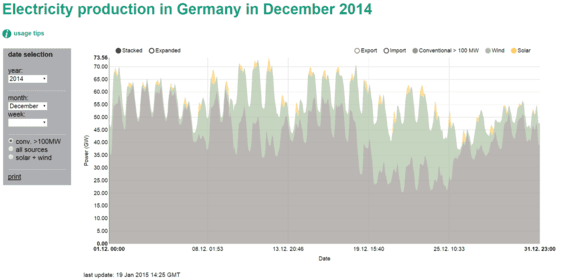EPEX has just published the update for power prices on the wholesale exchange for January. In the winter, the spread is the greatest between France and Germany. Year over year, prices in Germany were down by a fifth in January, but the effect is probably partly due to record wind power production.
Over at France’s DD Magazine, Yves Heuillard explains how France benefited from lower wholesale prices thanks to the surge in wind power production in the second half of the month “despite French demand for electric heat.” Nonetheless, French power was 17 per cent less expensive in December 2014 than it was in December 2013, when there was much greater demand for heat during a cold spell.
In 2014, prices on the German exchange dropped by 13 percent on average for baseload and 15 percent for peak prices. But January 2015 was a record month for wind power production in Germany, with 9.776 TWh having been generated for the month as a whole (244 GWh of which was from offshore).
The record wind power production has stretched the gap between prices in the Phelix zone and neighboring France and Switzerland, as the chart from EPEX’s press release shows. Baseload power in Germany cost more than 1.2 cents less than in France, while peak power was nearly a cent cheaper in Germany as well.
Costs are being entailed elsewhere, however. Grid operators say that the dispatching during the storms in December led to costs totaling as much as 13 million euros, which will be passed along as a part of the grid fee. The same report also says that Germany’s “winter reserve” – oil and gas plants on standby, some of which are in Austria – were resorted to for the first time since early 2013 on December 20 and 22. A total of 2,400 megawatts had to be switched on during those days.
Ironically, as the chart of power production for December shows, those were days on which significant amounts of wind power were available. But the winter reserve is located in the south, whereas most wind power is generated in the North. The shortfalls are therefore clearly local. Those who oppose expanding the grid from north to south should take the current situation into account.
Source: Renewables International. Reproduced with permission.










